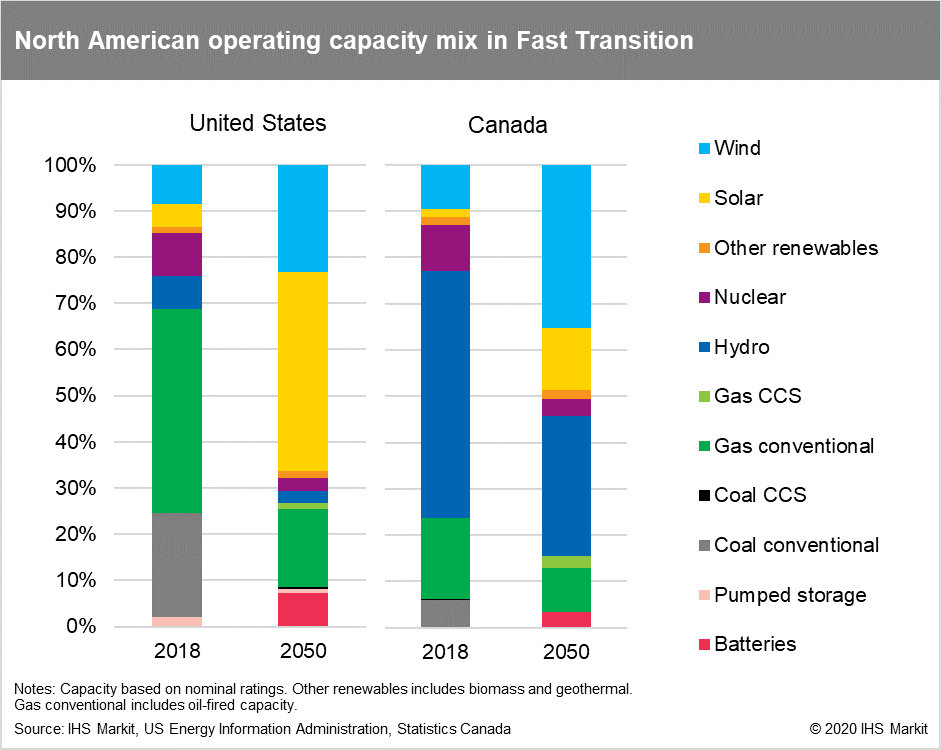Thermal resources’ role in a deeply decarbonized North American power system
Maintaining power grid reliability will be a major challenge in a deeply decarbonized future. The need to maintain reliability was a significant consideration in the construction of the recently released IHS Markit Fast Transition analysis, which explores deep decarbonization in the North American power sector while also taking major steps toward decarbonizing the broader economy through electrification.
IHS Markit's Fast Transition describes a pathway for achieving economy wide carbon emission reductions exceeding 70% in both the United States and Canada by 2050, and greater than 90% decarbonization in the power sectors. Several factors were included to maintain system reliability, including the perpetuation of significant natural gas-fired thermal capacity resources to help ensure reliability. Such an approach is sometimes viewed as being at odds with deep decarbonization objectives, but Fast Transition demonstrates that deep power sector decarbonization can be achieved even while natural gas-fired generators continue to operate at low capacity factors.
Natural gas-fired capacity plays a key reliability role in Fast Transition
Fast Transition draws several arrows from the reliability quiver to manage supply/demand misalignments, spatially and temporally. A significant expansion of transmission capacity balances interregional supply/demand (addressing the spatial aspect). The addition of several hundred gigawatts of battery energy storage helps address hourly, and in some cases daily, supply/demand misalignments (addressing the temporal aspect). Assumed increases in dispatch flexibility for zero-carbon base-load technologies (such as geothermal and fossil fuel-fired generators with CCS) also aid in the temporal accommodation of variable output renewable generation.
But longer term, seasonal misalignment of renewable supply with demand cannot be accomplished through these approaches alone. Technology that can carry a large energy inventory is needed. In Fast Transition, this act is accomplished by maintaining a fleet of natural gas-fired generators operating at a low capacity factor.
Our approach to reliability under Fast Transition results in more than 520 GW of gas-fired capacity remaining in the United States by 2050 and more than 30 GW in Canada. This installed natural gas-fired capacity is significant, and similar to today's installed capacity in gigawatt terms, but represents a much smaller proportion of total nominal capacity in 2050. However, the installed natural gas-fired generator fleet will not be used during most of the year. The output from natural gas-fired generators (including those with CCS) is about 11% and 3% of total generation in the United States and Canada, respectively, by 2050. Thermal generation will serve as a reliability resource in the future Fast Transition power system.

Figure 1: North American operating capacity mix in Fast
Transition
Can natural gas be entirely eliminated from the power system?
Fast Transition demonstrates that significant natural gas-fired capacity (with limited natural gas use) and deep decarbonization goals are not mutually exclusive. However, as local, national, and global discourse shifts to net zero greenhouse gas-emitting economies by midcentury, additional measures beyond those explored in Fast Transition could be implemented that more severely restrict natural gas use.
- Fuel switching. Thermal generation resources could avoid obsolescence and continue to operate in a natural gas-prohibited world by changing their fuel supply to "green fuels" like hydrogen or low-carbon or carbon-negative biofuels and other forms of renewable natural gas.
- Increased transmission. Another measure for managing reliability is building more long-distance high-voltage transmission than already built in Fast Transition to spatially address region-specific supply/demand misalignments and minimize the need for expensive inter-seasonal energy storage.
In Fast Transition, we have achieved greater than 90% power sector decarbonization while still allowing for continued but limited operation of natural gas-fired resources to meet reliability criteria. Understanding the shape of the incremental power system total cost curve while meeting reliability criteria as the economy deeply decarbonizes is a subject for further research, analysis, and intense debate.
Learn more about our North American power research.
Barclay Gibbs is a Senior Director for the North
American Power Analytics team at IHS Markit.
Mark Griffith is a Director of the Power, Gas and Coal team at IHS
Markit.
Wade Shafer is a Director of the North America Power Analytics team
at IHS Markit.
Posted 02 April 2020.
This article was published by S&P Global Commodity Insights and not by S&P Global Ratings, which is a separately managed division of S&P Global.

